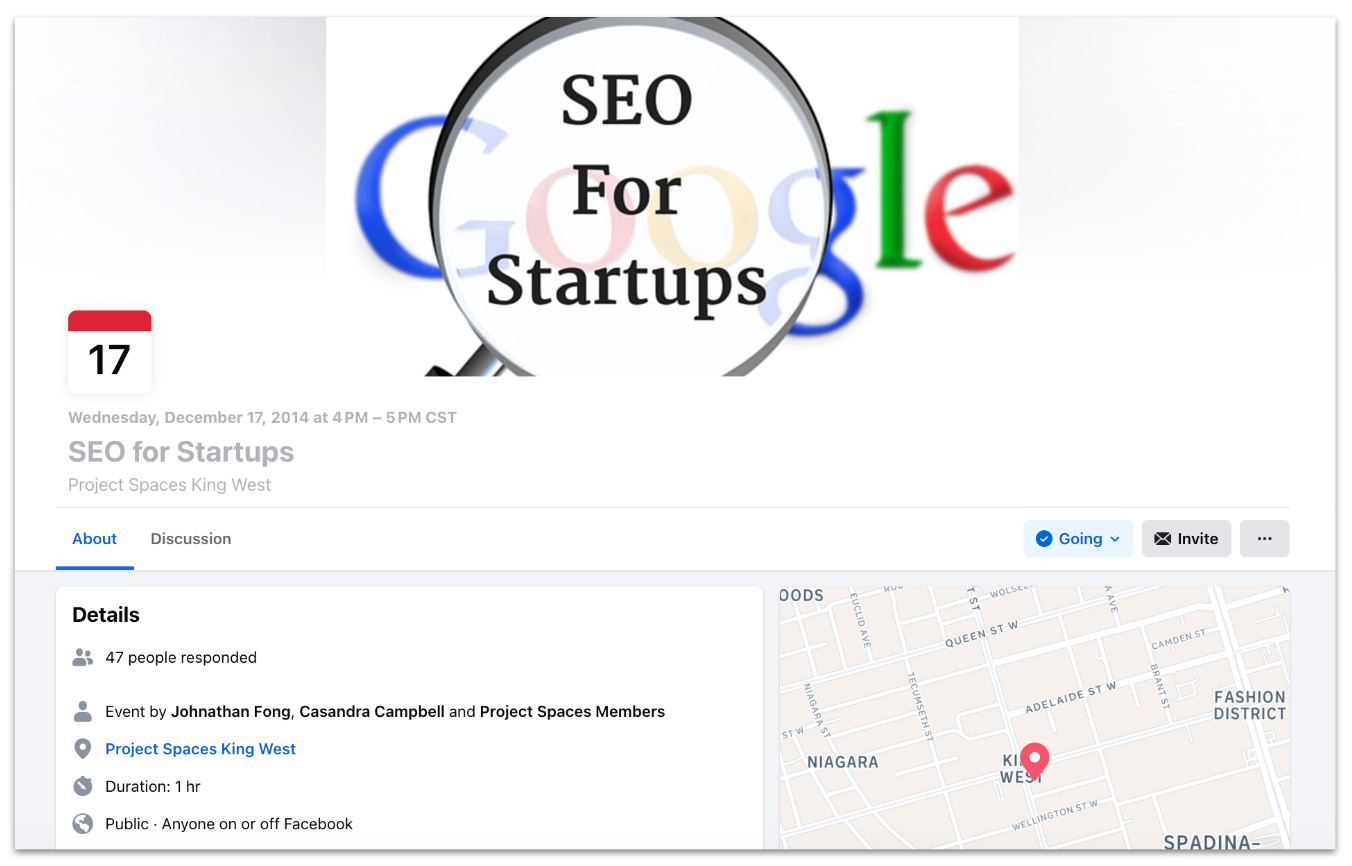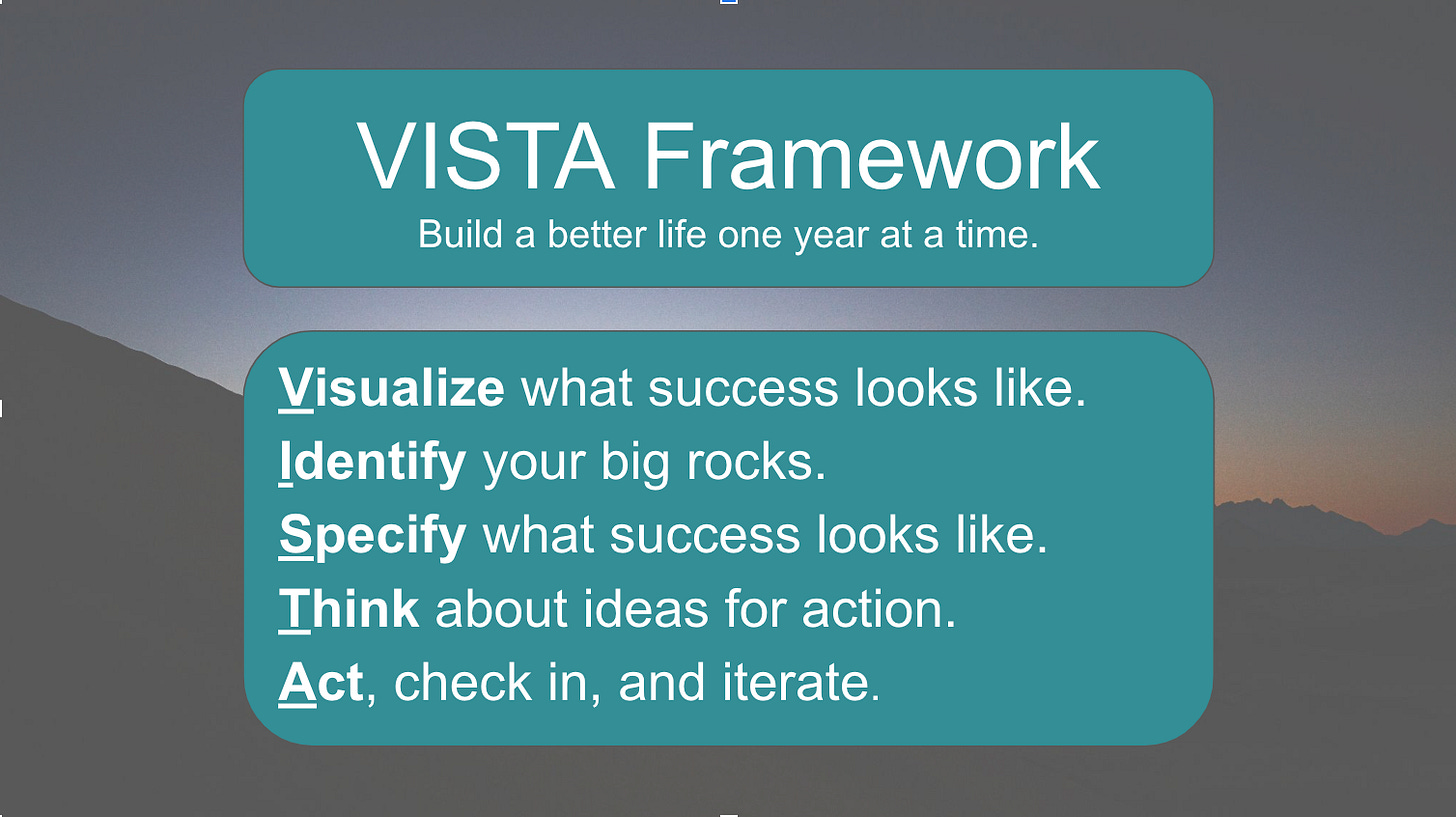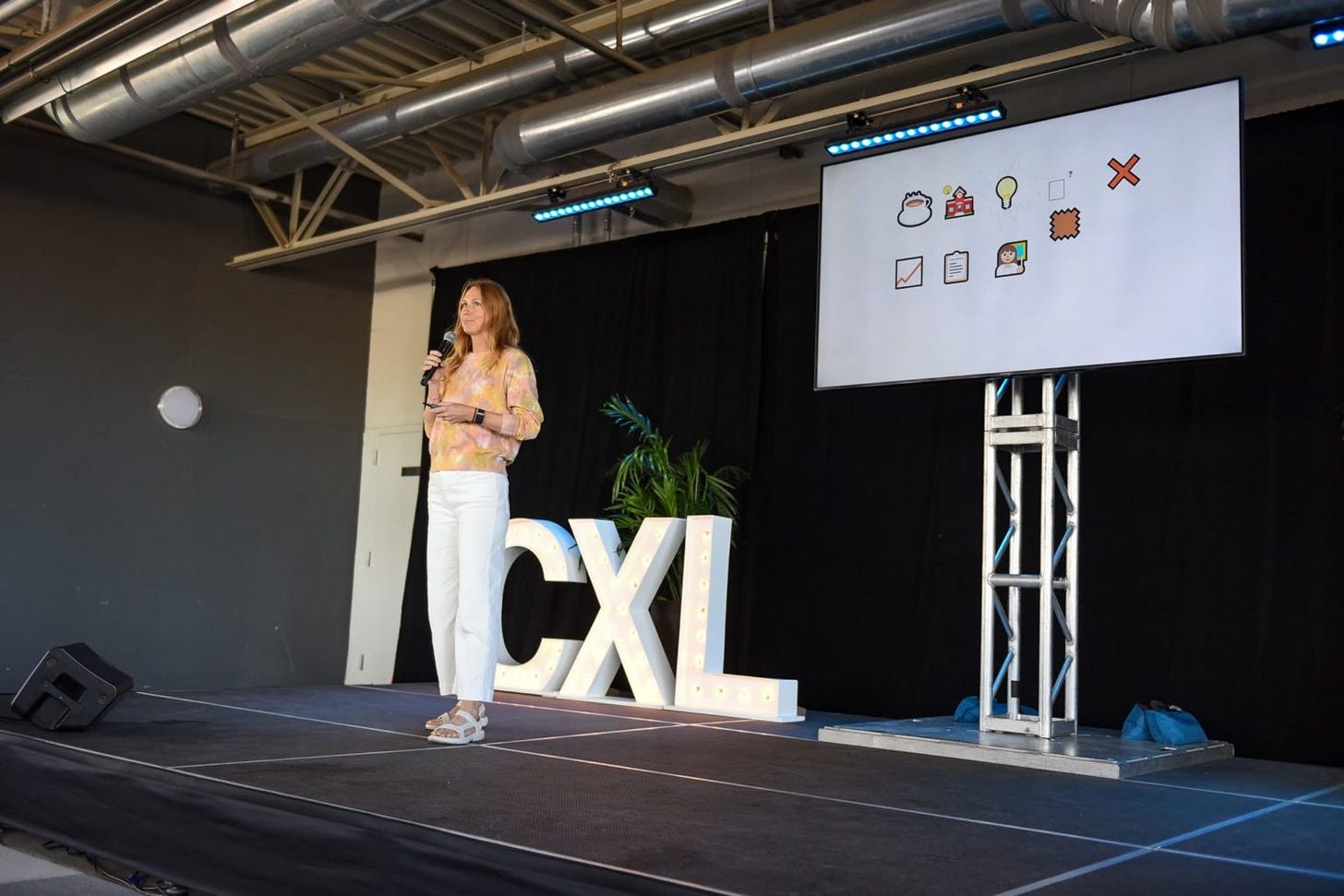How to Actually Have a Successful Year in 2025
The goal-achieving framework I use to design my life one year a time.
👋 Hey, I’m Casandra. I share really good business ideas to help you start and grow a business. Become a Premium subscriber to access the full archive (including 100+ research-backed business ideas). Premium subscribers also get access to Premium Perks.
How many times have you thought this is the year I will finally <insert goal here>?
Most of us get inspired at the beginning of a new year. We get swept up in each other’s excitement about what could be. We make New Year’s resolutions—often the same ones we’ve been making for years—and think, “This is the year I will actually do it.”
Some of us start out strong and make some progress until life gets in the way. But most of us never think of our resolutions again until the following year.
Meanwhile, we keep thinking, “When will my life finally look how I want it to?”
What if I told you there’s a better way?
New Year’s resolutions rarely work because they’re incomplete. They’re isolated goals that don’t ladder up to our broader views of success and lack a path towards completion.
This is why I gave up New Year’s resolutions years ago in favor of a more thoughtful process that has helped me dramatically alter my life in ways I even imagine when I started.
Introducing the VISTA Framework
VISTA is the framework I have been using for 10 years. Friends frequently remark that I have done a great job optimizing my life. This isn’t an accident. Every year, I think deliberately about what I want my life to look like and what steps I need to take to get there.
Visualize what success looks like.
Identify your big rocks.
Specify what success looks like.
Think about ideas for action.
Act, check in, and iterate.
What About SMART Goals?
You’re probably already familiar with SMART goals. SMART goals were created by management consultant George T. Doran in 1981 to help businesses be more effective. He introduced five criteria to help managers improve their success rate by clarifying their goals: specific, measurable, assignable, realistic, and time-related.
SMART goals are great for specific task-based goals, but they’re too narrow for life design.
Bigger-picture progress requires higher-level thinking. Most of us have a much broader definition of success than a specific salary, weight, etc.
Bigger-picture progress requires flexibility. Sometimes, circumstances change, and smaller, more specific goals need to change, too. You might originally think you want to lose 10 lbs but then realize what you actually want to do is build muscle, and that requires a different measure.
It’s not enough to just state your goals. If you want to achieve them, you must also figure out the path forward. You're unlikely to make much progress without a map of how to get there.
The VISTA process connects a bigger-picture view of success to the flexible actions you’ll take to get there. While SMART goals can play a role in the process, VISTA is a much more holistic approach (which is also why it’s more effective).
Today, I’ll walk you through building your 2025 VISTA and share examples from my own VISTA building.
Visualize What Success Looks Like 👀
The first step is to visualize what a great year looks like. It’s helpful to do this on multiple levels of abstraction.
Success on a Macro Level
Fast forward a year from now. It’s December 31, 2025. You’re reflecting on the past year and thinking about everything you accomplished. You’re proud, but more than that, you’re happy. Life is starting to look the way you want it to. What do you see? Jot down everything that comes to mind.
Here’s an example I used a few years ago when I had been dealing with a lot of chronic injuries.
I’m active daily, and my body feels great. I don’t have to think much about whether I can do something, and my friends know I’m usually up for anything outdoors. I can run and strength train again multiple times a week without any pain. I’m starting to think about specific training goals, and I know they are finally within the realm of possibility.
Note that this is only one aspect of what a successful year looked like then. Think about health, career, relationships, finances, travel, home, hobbies, and anything else that is important to you.
Success on a Micro Level
Think about an ideal day. What does it feel like? What do you do? Who do you see? How do you spend your time? Jot down an outline and make sure you incorporate work into your day. (E.g., an ideal day if you don’t win the lottery). Be very specific because the details you uncover can become essential for uncovering what success truly looks like for you.
Here’s an example of an ideal day for me.
Wake up naturally (no alarm clock).
Do some mobility followed by light work (e.g., emails).
Have a small breakfast at home.
Surf for a couple of hours.
Come home, shower, and prepare lunch.
Deep work for a few hours, ideally in a beautiful office with a view of nature outside the window.
Do some prep for dinner.
Do a workout (strength, running, more surfing).
Make and eat dinner outside with friends.
Go for a sunset walk.
Read some fiction in bed before going to sleep.
My days don’t look exactly like this, but they’re not that different either. That’s because, over time, I have tried to design my life to fit my ideal day. (I actually have multiple ideal days, as you probably do, too).
Here are some examples of how my ideal impacts my major life decisions:
I don’t schedule meetings in the morning because waking up naturally is important to me. Even when I worked at a big company, my calendar was blocked in the morning.
I don’t need to spend money on office space because I’d rather work at home where I can cook my own meals (and hang out with my cat!). I also wouldn’t take a non-remote job for these and other reasons.
I hate having a full calendar or a lot of meetings, so I don’t do much client work. Instead, I’m more focused on building the product side of my business.
I want to be able to surf every day when there are waves, so I live close to the ocean and keep a flexible schedule to adjust to the ocean’s whims.
Identify Your Big Rocks 🪨
In goal setting, "big rocks" are your most important priorities. The term comes from a popular metaphor popularized by Stephen Covey in his book First Things First, where he explained, “If the big rocks don’t go in first, they aren't going to fit in later.”
Take what you wrote down in your visualization exercises and lay out some big rock priorities or themes for the year. Each one should effectively summarize an important area you want to focus on.
I find that 3-5 typically work best. What you don’t choose is just as important as what you do. If you have too many big rocks, you’ll spread your attention too thin and won’t accomplish any of them.
They don’t have to be specific yet (but they can be). Some goals are more qualitative, and that’s ok. One could be to make your first dollar online (specific and quantitative), while another could be to incorporate more creativity into your life (not specific and qualitative).
They don’t need a specific scope or size as long as they differ sufficiently. For example, one might be to double your client roster, and another might be to learn pickleball.
Don’t just stick to work or personal themes. Think about what a successful year means for your life more broadly.
Focus on things that won’t happen unless you get more deliberate. You don’t need to add extra focus if it's likely to happen organically. For example, if you’re already on track for a promotion next year and it’s not very far out of reach, you might want to focus on something else instead (like learning a new skill that will help with the next promotion after that).
Here are a few examples of some of my big rocks from past years:
(2014) Give a public presentation: Going into 2014, I wanted to get into public speaking but had never done it before. I didn’t really know where to start and knew it wouldn’t happen unless I got out of my comfort zone and figured it out.
(2015) Spend a consecutive month abroad. Going into 2015, I was very interested in exploring slower travel and a more nomadic lifestyle. I decided living somewhere else for a month would be a great first step, but I knew it wouldn’t be easy to schedule with my and my husband’s work.
(2022) Build my community in my new neighborhood: At the end of 2021, I moved to a new neighborhood in NYC and didn’t know many people there. I’m pretty introverted and like to spend a lot of time alone, so I knew I wouldn't meet many people unless I pushed myself to be more intentional about it.
Specify What Success Looks Like 🎯
Once you have identified your big rocks, the next step is to break them down into specific goals, when needed. Some broader big rocks will need more granularity on what they mean. As you’re doing this, try to answer the following question: What will success look like?
For example, if one of your goals is prioritizing your health, does it mean sleeping better? Running your first marathon? Finally getting your injuries treated? Being active every day? Adding 50 lbs to your bench press?
Now is the time to be as specific as you need to be. At the end of the year, you want to be able to answer the question, “Did I achieve what I set out to achieve.” In other words, “Was I successful?”
Think About Ideas for Action 🤔
Once you’ve defined success for each of your big rocks with more specific goals and accomplishments, it’s time to start brainstorming how you’ll achieve it.
This isn’t a precise action plan (that would be a waste of time). As you start working towards your goals, you’ll come across new ideas, ditch old ones that didn’t turn out to be as helpful as you hoped, and learn more about the best way to get from where you started to where you want to end up.
But you still need to get the wheels turning for a starting point. For each big rock, jot down things you can do to make progress on your goals. You can add or cross things off this list each time you revisit your VISTA.
For example, here are some of the ideas for action I wrote down for my 2022 big rock, “Build my community in my new neighborhood.”
Put out friendly vibes and say hello to people. (This was a mental shift from my default state).
Stay in touch with the people I’ve already met. (Low-hanging fruit!).
Attend local events and meetups. (This also included a list of specific ideas I kept adding to).
Host a party and ask each person to bring a friend.
Each time you visit your VISTA to check on your progress, you can mark off what you did and hopefully add others. When you realize you haven’t made much progress on a big rock, you’ll have a list of ideas to help you get going again.
Act, Check-In, and Iterate 📈
Your VISTA is a living document. Think of it as your HQ for the year. Throughout the year, you should check in and update your progress. Write down what you’ve accomplished so far, check off your actions, and add any new ideas. If you need to iterate on some of your goals, that’s ok, too.
You can check in as often as you want, but I recommend doing it at least once a quarter. Set aside an hour, pour yourself a cup of coffee (or other beverage of choice), and spend some time in your VISTA. I usually find it fun to stop and acknowledge my progress towards the life I want to live.
And when I haven’t made much progress, I get renewed motivation to take action!
Here’s a real example.
In Q4 of 2014, I still hadn’t made any progress towards giving my first presentation. I started talking about it with friends in my coworking space, and one of the founders suggested that I give a talk to the community. I asked the other members what they wanted to learn from me, and we set it up. I was extremely nervous, but this was the perfect way to achieve my goal and get started. I shared my SEO expertise in an informal setting with a group of friends and acquaintances who were eager to learn.

No matter how often you check in throughout the year, make sure you take some time to reflect on your progress at the end of the year. I love to finish logging everything I accomplished before starting the process again for the next year. Some big rocks will carry forward; others will be put to rest.
Here’s an example of a big rock I carried forward for multiple years before letting it go in favor of new big rocks.
In 2015, I carried my public speaking big rock forward. Once I had gotten over the initial hump, I started to find more opportunities and gave myself a rule that I had to say yes to any requests so that I could get a lot of reps in and practice.
I guest lectured about e-commerce in a university class.
I taught librarians about blogging.
I even let multiple journalism students interview me about my brewing company for their class (meaning no real PR for us).
By 2017, I started speaking at big conferences with great feedback, eventually recording an online course for Shopify and being hired to teach marketing and analytics courses at a coding boot camp.
We all have constraints to work within, and we’re all subject to luck (both good and bad). But that doesn’t mean we don’t have a lot of say in our futures. Instead of going along with the status quo, think more deliberately about what you want to achieve. No matter how crazy it seems right now, if you keep putting one foot in front of the other, you can create a path to get there. You’ll be amazed at what you can accomplish!
To endless possibilities,
Casandra
PS. Is one of your 2025 goals to start a business? Join Really Good Business Ideas Premium and get instant access to research-backed business ideas, educational content to help you succeed, and tools to make it easier. Premium subscribers can also access my help directly during office hours and through DM support.







I love this alternative approach to SMART goals, so interesting
My VISTA is going in my journal today!